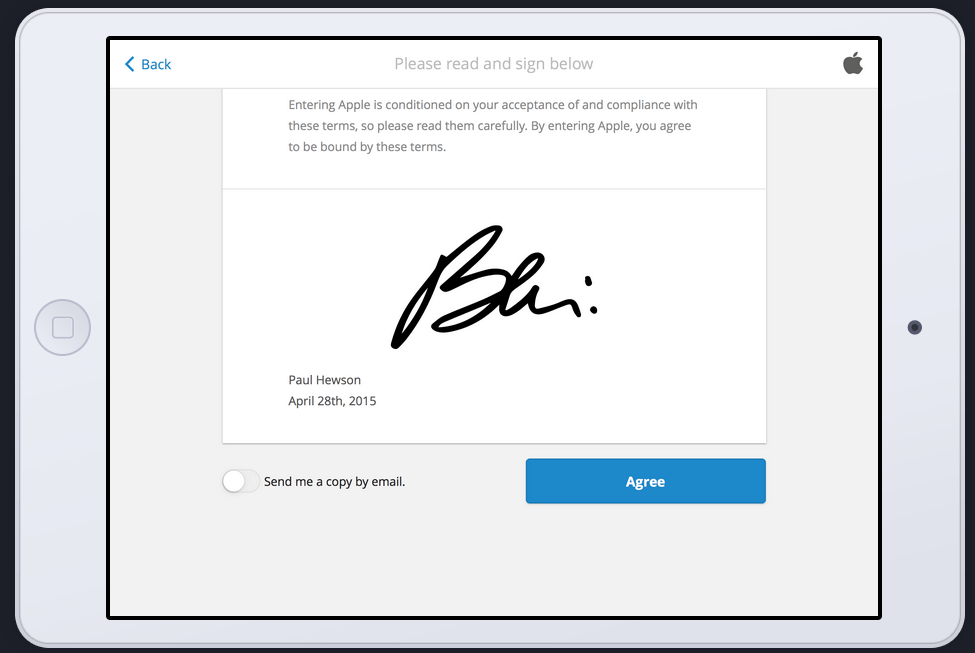Consumers and businesses are increasingly presented with a touchscreen where they have to sign with their finger. The same is true for visitors to offices who are often requested to sign before entering the location they are visiting.
However what if there are any disagreements - is the signature valid? As it relates to businesses' regulatory compliance, let's talk about the legality if an electronic signature on an iPad.
In view of the launch of the new kiosk app, including signed NDAs, we asked our legal counsel (one of the Big 4) to give us a legal insight into the world of electronic documents and signatures. Here is what they said.
Electronic signatures: Are they legal?
Many people are still reluctant to use electronic documents or signatures, questioning their legal validity and the ability to use them as evidence, if for any reason they needed to be used in a legal context.
In most Western countries, such reluctance is unnecessary as legislation has been updated to recognize both electronic documents and signatures.
Simply put, these cannot be denied legal effect, enforceability or admissibility as evidence in legal proceedings solely on the grounds that they are in electronic form.
This has recently been updated to apply to all EU countries directly by Regulation (EU) No 910/2014. The EEA countries have similar legislation, while in the USA the Electronic Signatures in Global and National Commerce Act, the Uniform Electronic Transactions Act and other (state) acts regulate this area.
Which electronic documents are actually valid?
Any electronic version has to be considered equal to its equivalent paper one ensuring it ‘satisfies the functional characteristics of the formal requirements of the applicable law’.
It is only in specific situations that an explicit paper document has to be used, e.g. to buy real estate in most countries, you’ll have to go to a notary or legal representative for a deed.
Luckily, in most business or personal situations the document format is the individual’s choice, even to the extent of a contract written on a napkin, if they so wish! If electronic is your preference then most immediately think of a PDF file, but there are actually no defined limits on acceptable formats.

Electronic signatures are more complex
The legal validity of electronic signatures is a more complicated area because several countries have taken a different approach.
Electronic signature law (such as in the EU) often makes the diversification between ‘normal’ electronic signatures (e.g. email signatures) and more secure solutions.
These include ‘qualified’ electronic signatures, which use amongst others certificates, and are offered by ‘qualified trust service providers’. We’re not going to cover a full explanation of qualified electronic signatures here, but it is notable that, at least in the EU and EEA, a ‘qualified electronic signature’ has the same legal value as a handwritten signature.
The legal validity of electronic signatures
So, does this mean that other electronic signatures such as email signatures, authenticator token signatures (e.g. for e-banking), or those placed on a touchscreen signed with a pen or a finger (e.g. for deliveries), have no legal validity and can’t be used as evidence in court?
This is definitely not the case as these cannot be denied legal effect and admissibility as evidence in legal proceedings solely on the grounds that they are electronic.
This type of signature has legal value as soon as the mechanism or platform used to obtain it creates ‘data in electronic form which is attached to or logically associated with other data in electronic form and which is used by the signatory to sign’.
The biggest legal difference between a ‘non-qualified’ electronic signature and a ‘qualified’ one is that, in court, the relevant party has to prove that a non-qualified one is authentic. In the case of qualified electronic signatures, the counter-party has to prove that the signature was not valid.
Options to ensure authenticity
It is easier to prove some non-qualified electronic signatures as authentic over others and an important case for authenticity is the unique link of the signature with the signatory.
For example, when you type your name at the end of an email, that signature is not uniquely linked to you as anyone can type this. However, if you hand write your signature on a touchscreen, you would be the only one who is able to create it, as it is unique to you. So this form of signature should, in principle, be a better solution than to rely on a typed email one.
You can enhance this further with a photo record e.g. if a visitor to your business signs your NDA on an iPad, the authenticity of the signature becomes even more valid if a picture of them is taken as part of the visitor registration or check-in process.

Moving forward with electronic signatures
It is important that whatever solution that uses your electronically transposed handwritten signature has to be secure to prevent any alteration of the signature and the signed data, from the time of signing.
While it is often said that legal frameworks have not kept up with the rapid and ever evolving advances in technology, that is definitely not the case in the area of electronic documents and electronic signatures.